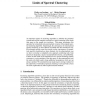Free Online Productivity Tools
i2Speak
i2Symbol
i2OCR
iTex2Img
iWeb2Print
iWeb2Shot
i2Type
iPdf2Split
iPdf2Merge
i2Bopomofo
i2Arabic
i2Style
i2Image
i2PDF
iLatex2Rtf
Sci2ools
111
Voted
NIPS
2004
2004
Limits of Spectral Clustering
An important aspect of clustering algorithms is whether the partitions constructed on finite samples converge to a useful clustering of the whole data space as the sample size increases. This paper investigates this question for normalized and unnormalized versions of the popular spectral clustering algorithm. Surprisingly, the convergence of unnormalized spectral clustering is more difficult to handle than the normalized case. Even though recently some first results on the convergence of normalized spectral clustering have been obtained, for the unnormalized case we have to develop a completely new approach combining tools from numerical integration, spectral and perturbation theory, and probability. It turns out that while in the normalized case, spectral clustering usually converges to a nice partition of the data space, in the unnormalized case the same only holds under strong additional assumptions which are not always satisfied. We conclude that our analysis gives strong evidenc...
Clustering Algorithm | NIPS 2004 | NIPS 2007 | Normalized Spectral Clustering | Spectral Clustering |
Related Content
| Added | 31 Oct 2010 |
| Updated | 31 Oct 2010 |
| Type | Conference |
| Year | 2004 |
| Where | NIPS |
| Authors | Ulrike von Luxburg, Olivier Bousquet, Mikhail Belkin |
Comments (0)

